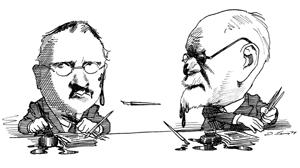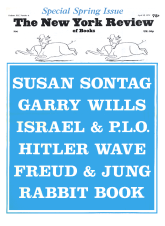In view of the fact that both Freud and Jung have made a great stir in the world and that the ideas of both of them have become part of the intellectual climate of our time, the publication of their letters to each other is obviously an event of some general interest—and of some importance to scholarship. This volume is therefore to be welcomed, since it will form an essential source of material to anyone wishing to do research into the history of the psychoanalytical movement. Having said this, I must, unfortunately, add that the letters themselves, and the way in which they have been edited, will deter all but the most determined readers from actually reading The Freud/Jung Letters straight through as a book.
The first obstacle anyone trying to read these letters will have to surmount is the discovery that they have been published against the express wishes of one of the correspondents, while the views of the other one are not known. Although Jung issued contradictory statements on the matter, at no time did he give permission for his letters to be published before 1980, and at no time did he express any positive wish that they should ever be published at all—indeed quite the contrary.
My letters were never written with any thought that they might be broadcasted. As a matter of fact, many of them contain unchecked and highly objectionable materials, such as are produced in the course of an analysis, and shed a most one-sided and dubious light on a number of persons who I don’t want to offend in any manner whatever. Such material enjoys the protection of the secretum medici. These people or their descendants are still alive.
And in his television interview with John Freeman, Jung rejected the suggestion that these letters were “probably of great historical importance” with “I see no particular importance in them.”
Secondly, the correspondents’ literary executors, Franz Jung and the late Ernst Freud, decided in order to guarantee impartiality that the letters should be printed as historical documents, without any commentary, and the editor, William McGuire, has abided by their decision. As a result, The Freud/Jung Letters is in no sense an account or history of the relationship between Freud and Jung—as is claimed of it—but merely provides some of the raw material on which such a history could be based. Although footnotes are frequent, they are confined to identifying the various persons and places named, the sources of all literary quotations and allusions, and to mentioning the occasions on which Freud and Jung met. Some of the notes are ridiculously pedantic; they include a speculation about the identity of someone named in the beginning of a sentence, the remainder of which is missing, and the information that the Latin tag “Nemo me impune lacessit” is not of ancient origin but was coined as the motto of the Order of the Thistle of Scotland—in which case, to cap pedantry with pedantry, it probably dates from 1687.
As a result, anyone who tries, as a reviewer inevitably must, actually to read the book, gets lost in a maze of unexplained allusions. What, for instance, is he to make of the following reference to Ernest Jones in a letter of Freud’s? “From Jones and about him I have received very strange news and I am in very much the same situation as you when he was with Kraepelin.” And is he justified or not in correlating it with a sentence in Jung’s reply: “The interior of Africa is better known to me than his sexuality”?
Furthermore, anyone trying to read this book straight through is bound to be distracted by tantalizingly incomplete accounts of the extraordinary careers and mental illnesses of a number of people whose names recur throughout the correspondence; particularly perhaps by the strange story of Otto Gross, who appears first as a psychiatrist respected by both Freud and Jung and, in a footnote, an ex-lover of Frieda von Richthofen (later Frieda Lawrence), then as a patient of Jung, who analyzed him successfully in a fortnight, and later as an incurable case of dementia praecox who died of starvation. (This, incidentally, does not tally with Jones’s account of Gross, which asserts that “his life came to an end through murder and suicide.”) This book, in fact, achieves impartiality between Freud and Jung at the expense of half-telling a number of very strange, and often tragic, stories about their friends, colleagues, and patients.
Thirdly, something is amiss with the translation, though I am not sure who, if anyone, is to blame for this. Freud was a stylist who was awarded the Goethe Prize in 1930, but no trace of literary ability comes through in the translation and one is left not knowing whether in his personal correspondence he constructed sentences which accuracy demands should be translated as awkwardly as the sentence about Jones I quoted earlier. Furthermore, both Freud and Jung were in the habit of using psychoanalytical jargon indiscriminately and this at times creates curious effects. For instance, they both used the word “auto-erotic” to describe not only regressive phenomena observed in their patients but also their personal impressions of people they met socially; as a result they often described someone as being auto-erotic when what, one surmises, they really meant is what contemporary analysts mean when they say that someone is “narcissistic,” i.e., that they are smug or conceited. When Jung writes that Frau Abraham “suffers from Berlinese auto-erotism,” which sounds both strange and offensive, I imagine that he only meant that he found her smug in a way that he thought was typical of Berliners.
Advertisement
Fourthly, Ernest Jones had access to this correspondence when he was writing his life of Freud, so an account of the friendship and eventual rupture between Freud and Jung, which takes cognizance of the letters they wrote each other, is already in existence. And, not surprisingly in view of both Jones’s integrity and the fact that he must have realized that the correspondence would eventually be published, there is no glaring discrepancy between his account of the Freud-Jung relationship and the blurred if more detailed impression that emerges from the letters. The scientific differences between Freud and Jung are, again not surprisingly, better explained by Jones’s retrospective account than by the theoretical passages of the letters, which are often too condensed to make much sense.
The one omission in Jones’s account is that he fails to reveal that Frau Jung was far from being a nonentity in the relationship between her husband and Freud. The seven letters from her to Freud included in the Letters show that she realized that the friendship was in jeopardy before either Freud or Jung themselves did, and that she tried to prevent the rupture by appealing to Freud to review his attitude toward his sons, both actual and intellectual. She also suggested to Freud that the physical ill-health of his children was perhaps neurotic and that they should be analyzed. It is clear too from one of the letters, one which Jones refers to but does not quote, that Freud must have had at least one intimate conversation with Frau Jung, in which he expressed profound dissatisfaction with his life and marriage. “You said that your marriage had long been ‘amortized,’ now there was nothing to do except—die.” At the time of this conversation Freud must have been fifty-five and Frau Jung twenty-nine. It must presumably have been these letters from Frau Jung which led Jones defensively to give such a glowing account in his Life of what an excellent husband and father Freud was. Freud’s replies to Frau Jung have not survived.
Jung, incidentally, claimed to have analyzed his wife, a task which Freud says he would have thought impossible. It is, however, hard to know what Jung meant by such a statement, since he also claimed to have analyzed fifteen Negroes while on a short visit to Washington, DC.
Fifthly, many of the letters are about professional politics and patients, and are incomprehensible in any deep sense in the absence of relevant background information. It would, for instance, have been helpful to have been told a little about the economics and ethical code of private practice psychiatry in Central Europe in the years (1906-1912) covered by the correspondence. Several incidents are described in these letters which would raise eyebrows if they occurred in London in 1974.
Anyone, however, who does persevere with these Letters will agree with Jung that they contain “highly objectionable materials.” Both Freud’s and Jung’s letters are consistently disparaging and contemptuous of others, and I doubt whether Jones, Abraham, or Eitingon—all later members of the famous “Committee” of analysts especially close to Freud—would have ever got involved in the psychological movement if they had known at the time what Freud and Jung were saying about them. In one of his angry letters written near the end of their relationship Jung says, “I am forced to the painful conclusion that the majority of psychoanalysts misuse psychoanalysis for the purpose of devaluing others and their progress by insinuations about complexes.” The Freud/Jung Letters reveal that both Freud and Jung himself were frequently guilty of character assassination by pseudoobjective insinuation and that, while they were friends, they egged each other on into a folie à deux of malice that was characteristic of neither of them when apart. The publication of The Freud/Jung Letters will damage the reputation of both of them, which is a pity, since their writings intended for publication still have much to teach us.
Advertisement
In addition to leaving a nasty taste in the mouth, these letters are also depressing, since time and again Freud and Jung announce that they have solved, or are just about to solve, problems which are still exercising us today, sixty years later.
This Issue
April 18, 1974




